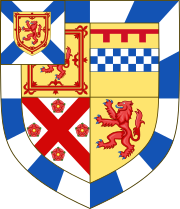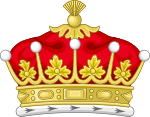Earl Castle Stewart facts for kids
Quick facts for kids

Arms: Quarterly: 1st, Or a Lion rampant Gules, armed and langued Azure, within a Double-Tressure flory counter-flory Gules (Scotland); 2nd, Or, a Fess chequy Azure and Argent, in chief a Label of three-points Gules (Stuart); 3rd, Argent, a Saltire between four Roses Gules, barbed and seeded proper (Lennox); 4th, Or, a Lion rampant Gules (Macduff); the whole within a Bordure compony Argent and Azure. Crest: A Unicorn’s Head Argent, armed and maned Or. Supporters: On either side a Wyvern tail nowed Or, armed proper and langued Gules.
|
|
| Creation date | 29 December 1800 |
|---|---|
| Monarch | George III |
| Peerage | Peerage of Ireland |
| First holder | Andrew Stuart, 1st Viscount Castle Stewart |
| Present holder | Arthur Stuart, 8th Earl Castle Stewart |
| Heir apparent | Andrew Stuart, Viscount Stuart |
| Subsidiary titles | Viscount Castle Stewart Baron Castle Stuart Baronet ‘of Castle Stewart’ |
| Status | Extant |
| Seat(s) | Stuart Hall, near Stewartstown |
| Motto | FORWARD |
The title of Earl Castle Stewart is a special noble rank in Ireland. It was created in 1800 for a person named Andrew Thomas Stewart. This title is part of the Peerage of Ireland, which is a system of noble ranks in Ireland. The Earls Castle Stewart are proud to say they are direct descendants of the Scottish Royal House of Stuart.
Contents
The Stuart Family's Royal Roots
The Earls Castle Stewart come from a very old and important family. They are directly related to King Robert II of Scotland. One of their ancestors was Sir Walter Stewart, who lived a long time ago and was in charge of Dumbarton Castle.
Early Lords Avondale
Sir Walter's son, Andrew Stuart, became a noble called Lord Avandale in 1459. He was also a very important person in Scotland, serving as the Lord Chancellor of Scotland. This means he was a top government official.
Another family member, Andrew Stewart, was given the title Lord Avondale again around 1499. Sadly, he was one of many Scottish nobles who died in a big battle called the Battle of Flodden in 1513.
From Avondale to Ochiltree
Andrew Stewart, the second Lord Avondale, made a trade in 1542. He swapped his Lordship of Avondale for another one called Ochiltree. This meant he became Lord Stuart of Ochiltree.
His grandson, Andrew Stuart, became the third Lord Ochiltree. He was a close friend and advisor to King James VI of Scotland (who later became King James I of England). To get money, he gave up his Lordship of Ochiltree in 1615.
Becoming Baron Castle Stuart
Because he gave up his old title, King James I gave Andrew Stuart a new one in 1619: Baron Castle Stuart in the Peerage of Ireland. Andrew had moved to Ulster in Ireland in 1611. There, he was given a large amount of land in County Tyrone.
His son, Andrew Stewart, became the second Baron. In 1628, he also received another special title: a Baronet in the Baronetage of Nova Scotia. The second Baron built his home at Roughan Castle and helped start the nearby town of Stewartstown, County Tyrone.
Challenges and Changes
The third Baron, Sir Andrew Stewart, fought as a Royalist (someone loyal to the King) during the English Civil War. He had only one daughter, Mary, who inherited most of the family's land in Ireland. This land later went to her husband's family.
The title of Baron Castle Stuart then passed through several family members. For 88 years, the title was not officially claimed because the land that went with it was no longer with the family.
Reclaiming the Title and Becoming Earl
In 1774, Andrew Thomas Stewart successfully asked the King to recognize him as the rightful 9th Baron Castle Stuart. He was the great-grandson of the de jure (rightful, but unclaimed) 7th Baron.
Andrew Thomas Stewart was honored even more later on. In 1793, he became the 1st Viscount Castle Stuart. Then, in 1800, he was given the highest title yet: the 1st Earl Castle Stewart. All these titles were part of the Peerage of Ireland.
Later Earls
The first Earl's eldest son became the second Earl. His grandson, the fifth Earl, added the name Richardson to his surname. He had no sons, so the title went to his cousin, who became the sixth Earl.
The sixth Earl had two sons who sadly died in the First World War. So, his third son became the seventh Earl in 1921. This Earl, Arthur Stuart, was a politician and served in the House of Commons. He married Eleanor May Guggenheim. His two oldest sons also died, but in the Second World War.
As of 2014, the current holder of the titles is the eighth Earl, Arthur Patrick Avondale Stuart, who became Earl in 1961.
The family's main home is Stuart Hall, which is near Stewartstown, County Tyrone.
Who Holds the Titles?
Here are some of the people who have held these important titles:
Lords Avondale (around 1499)
- Andrew Stewart, 1st Lord Avondale (died 1513)
- Andrew Stewart, 2nd Lord Avondale (died 1548) (He traded this title for Lord Stuart of Ochiltree in 1542)
Lords Stuart of Ochiltree (1542)
- Andrew Stewart, 1st Lord Ochiltree (died 1548)
- Andrew Stewart, 2nd Lord Ochiltree (around 1521–1591)
- Andrew Stewart, 3rd Lord Ochiltree (1560–1629) (He gave up this title in 1615 and became Baron Castle Stuart in 1619)
Barons Castle Stewart (1619)
- Andrew Stuart, 1st Baron Castle Stuart (1560–1629)
- Andrew Stewart, 2nd Baron Castle Stuart (died 1639)
- Andrew Stewart, 3rd Baron Castle Stuart (died 1650)
- Josias Stewart, 4th Baron Castle Stuart (died 1662)
- John Stewart, 5th Baron Castle Stuart (died 1685)
- Robert Stewart, 6th Baron Castle Stuart (died 1686) (The title was not claimed for a long time after this)
- Andrew Stewart, ''de jure'' 7th Baron Castle Stuart (1672–1715)
- Robert Stewart, ''de jure'' 8th Baron Castle Stuart (1700–1742)
- Andrew Thomas Stewart, 9th Baron Castle Stuart (1725–1809) (He officially claimed the title in 1774 and became Earl Castle Stewart in 1800)
Earls Castle Stewart (1800)
- Andrew Thomas Stuart, 1st Earl Castle Stewart (1725–1809)
- Robert Stewart, 2nd Earl Castle Stewart (1784–1854)
- Edward Stewart, 3rd Earl Castle Stewart (1807–1857)
- Charles Knox Stewart, 4th Earl Castle Stewart (1810–1874)
- Henry James Stuart-Richardson, 5th Earl Castle Stewart (1837–1914)
- Andrew John Stuart, 6th Earl Castle Stewart (1841–1921)
- Arthur Stuart, 7th Earl Castle Stewart (1889–1961)
- Arthur Patrick Avondale Stuart, 8th Earl Castle Stewart (born 1928)
The person who is expected to inherit the title next is the current Earl's only son, Andrew Richard Charles Stuart. He is known as Viscount Stuart.
Other Related Titles
You might also be interested in these other noble titles connected to the Stuart family:
- Duke of Albany (a very old title from 1398)
- Lord Avandale
- Lord Ochiltrie
- Earl of Arran (another title created in 1581)


